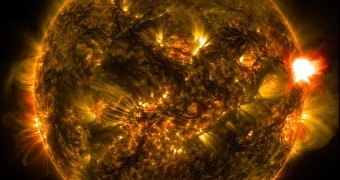A couple of days ago, our parent star, more prosaically known as the Sun, unleashed a freakishly powerful burst of radiation. The event, referred to as a solar flare, was documented by NASA's Solar Dynamics Observatory.
Since NASA scientists are not in the habit of keeping the wonders of the cosmos all to themselves, an image detailing the massive January 12 solar flare made it online just a few hours ago. The image in question is featured next to this article.
So, what's the deal with solar flares?
As mentioned, solar flares are essentially massive bursts of radiation. To the human eye, they appear as sudden flashes of brightness that spring seemingly out of nowhere on the surface of the Sun.
Astronomers explain that, whenever a solar flare occurs, particles such as electrons, ions and all sorts of atoms are ejected through the aura of plasma that surrounds the Sun into space. This small army of particles leaves the Sun in the form of clouds.
Although the radiation that is emitted during such an event is harmful, we humans are kept safe from it by Earth's atmosphere. Thus, the radiation cannot make it all the way through the atmosphere and reach us on the ground.
Still, this does not mean that we are completely immune to such bursts. On the contrary, solar flares can mess with the upper layer of the atmosphere, and in doing so, they can disturb GPS and communications signals.
“Harmful radiation from a flare cannot pass through Earth's atmosphere to physically affect humans on the ground, however, when intense enough, they can disturb the atmosphere in the layer where GPS and communications signals travel,” NASA explains.
The first massive solar flare of 2015
Scientists say that the flare that occurred this past January 12 was an M5.6-class one. What this means is that it was the first tremendously powerful burst of radiation our Sun has so far experienced this year.
As strong as this solar flare might have been, the fact of the matter is that, as it turns out, our Sun can do way better. Astronomers say that the most intense bursts that can occur on the surface of the Sun, dubbed X-class flares, are 10 times more intense than the January 12 one.
Hence, the burst of radiation that was documented a couple of days ago with the help of the Solar Dynamics Observatory is now said to have been a mid-level one.


 14 DAY TRIAL //
14 DAY TRIAL //